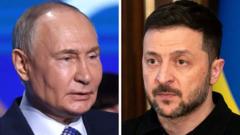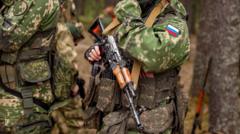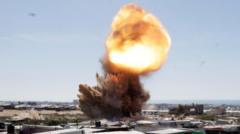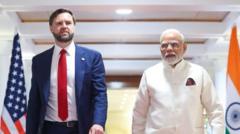Recent talks involving the US, UK, Germany, France, and Ukraine have aimed to establish a ceasefire in the ongoing war, yet fundamental disagreements and competing priorities leave the possibility of a resolution in doubt.
Diplomatic Efforts Escalate to End Ukraine Conflict, But Success Remains Uncertain
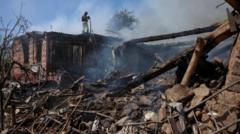
Diplomatic Efforts Escalate to End Ukraine Conflict, But Success Remains Uncertain
As diplomatic negotiations intensify among key nations, the path to peace in Ukraine appears convoluted, with major hurdles still to overcome.
The diplomatic landscape surrounding the Ukraine conflict is rapidly evolving, with renewed efforts to broker peace. High-level discussions are ongoing in London, involving representatives from the UK, Germany, France, Ukraine, and the United States. Simultaneously, Donald Trump's special envoy Steve Witkoff is set to meet with President Putin in Moscow for the fourth time, seeking to facilitate dialogue.
However, clarity regarding the direction of these diplomatic maneuvers is elusive. Previously, the United States had proposed a strategy that entailed an unconditional 30-day ceasefire, followed by negotiations aimed at achieving a long-term settlement. Ukraine had acquiesced to this plan, even conceding its demand for security guarantees linked to the cessation of hostilities.
Despite these steps, Russia's response has been markedly resistant, as President Putin emphasized the need for specific conditions to be satisfied before any talks of peace could commence. Central to Russia's stance are its concerns regarding NATO's expansion and the perceived threat posed by Ukrainian sovereignty.
In recent developments, US diplomats have suggested a potential framework for a ceasefire. This plan would involve Russia suspending its military actions while lifting its aspirations to gain control over the unoccupied regions of Luhansk, Donetsk, Zaporizhzhia, and Kherson. In exchange, the US would acknowledge these territories as Russian-controlled and recognize Crimea as legally part of Russia, a territory annexed during conflicts in 2014.
Ultimately, Ukraine’s stance remains hardline on Crimea; President Zelensky has reiterated that any concession regarding its sovereignty would require a referendum. Furthermore, European leaders have voiced strong opposition to the idea of recognizing Russian claims on Crimea, seeing it as a violation of international law norms.
Despite these significant barriers, some diplomats believe dialogue is possible, citing a willingness among parties to negotiate. However, critical aspects of the proposed agreement remain vague, with no clear plan addressing whether Western nations can continue to support Ukraine militarily. Additionally, Russia's insistence on a “demilitarization” of Ukraine has not been addressed in discussions, highlighting the divides that persist.
The proposed plan leaves open the potential for Ukraine to pursue European Union membership, yet uncertainty shrouds the deployment of any European security forces in the aftermath of a ceasefire, along with the future of economic sanctions against Russia.
The contrasting objectives of the parties involved paint a complex picture. Ukraine advocates for a conditional ceasefire followed by earnest discussions, while the US appears inclined to seek an expedited resolution, and Russia demands more detailed negotiations that often take extensive time to finalize. The delicate nature of these discussions reminds us that no agreements are settled until all terms have been thoroughly discussed and accepted. For now, progress remains tenuous at best.











